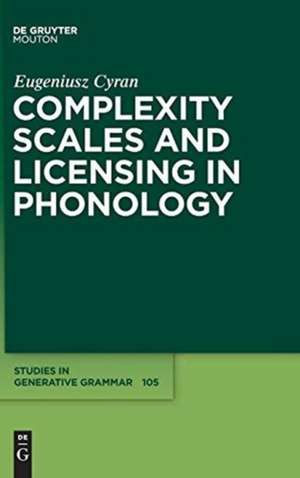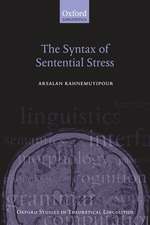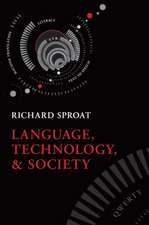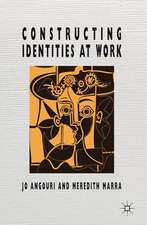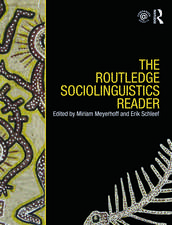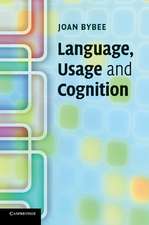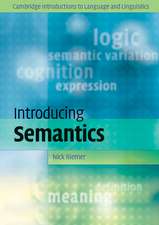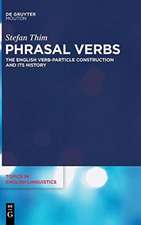Complexity Scales and Licensing in Phonology: Studies in Generative Grammar [SGG], cartea 105
Autor Eugeniusz Cyranen Limba Engleză Hardback – 16 mar 2010
Din seria Studies in Generative Grammar [SGG]
- 9%
 Preț: 740.86 lei
Preț: 740.86 lei - 9%
 Preț: 734.29 lei
Preț: 734.29 lei - 9%
 Preț: 748.66 lei
Preț: 748.66 lei - 9%
 Preț: 1007.71 lei
Preț: 1007.71 lei - 9%
 Preț: 737.86 lei
Preț: 737.86 lei - 8%
 Preț: 485.69 lei
Preț: 485.69 lei - 9%
 Preț: 1069.37 lei
Preț: 1069.37 lei - 9%
 Preț: 736.50 lei
Preț: 736.50 lei - 18%
 Preț: 1119.08 lei
Preț: 1119.08 lei - 18%
 Preț: 1050.75 lei
Preț: 1050.75 lei - 18%
 Preț: 1039.58 lei
Preț: 1039.58 lei - 18%
 Preț: 778.05 lei
Preț: 778.05 lei - 18%
 Preț: 974.16 lei
Preț: 974.16 lei - 18%
 Preț: 768.86 lei
Preț: 768.86 lei - 18%
 Preț: 933.17 lei
Preț: 933.17 lei - 9%
 Preț: 810.30 lei
Preț: 810.30 lei - 18%
 Preț: 1214.89 lei
Preț: 1214.89 lei - 18%
 Preț: 771.37 lei
Preț: 771.37 lei - 18%
 Preț: 903.85 lei
Preț: 903.85 lei - 18%
 Preț: 1043.92 lei
Preț: 1043.92 lei - 18%
 Preț: 1512.57 lei
Preț: 1512.57 lei - 18%
 Preț: 984.41 lei
Preț: 984.41 lei - 18%
 Preț: 1046.98 lei
Preț: 1046.98 lei - 18%
 Preț: 776.98 lei
Preț: 776.98 lei - 18%
 Preț: 1021.71 lei
Preț: 1021.71 lei - 18%
 Preț: 1057.23 lei
Preț: 1057.23 lei - 18%
 Preț: 1212.18 lei
Preț: 1212.18 lei - 18%
 Preț: 776.27 lei
Preț: 776.27 lei - 9%
 Preț: 898.96 lei
Preț: 898.96 lei -
 Preț: 350.83 lei
Preț: 350.83 lei - 23%
 Preț: 856.02 lei
Preț: 856.02 lei - 23%
 Preț: 1046.36 lei
Preț: 1046.36 lei - 23%
 Preț: 1042.66 lei
Preț: 1042.66 lei - 23%
 Preț: 1042.37 lei
Preț: 1042.37 lei - 23%
 Preț: 1050.49 lei
Preț: 1050.49 lei - 23%
 Preț: 1053.47 lei
Preț: 1053.47 lei - 23%
 Preț: 1317.99 lei
Preț: 1317.99 lei - 23%
 Preț: 1047.39 lei
Preț: 1047.39 lei - 23%
 Preț: 1044.29 lei
Preț: 1044.29 lei - 23%
 Preț: 1050.66 lei
Preț: 1050.66 lei - 9%
 Preț: 668.79 lei
Preț: 668.79 lei - 23%
 Preț: 1041.89 lei
Preț: 1041.89 lei - 23%
 Preț: 1045.76 lei
Preț: 1045.76 lei - 23%
 Preț: 1265.65 lei
Preț: 1265.65 lei - 23%
 Preț: 810.06 lei
Preț: 810.06 lei - 9%
 Preț: 670.15 lei
Preț: 670.15 lei - 23%
 Preț: 804.87 lei
Preț: 804.87 lei - 23%
 Preț: 812.00 lei
Preț: 812.00 lei - 23%
 Preț: 800.72 lei
Preț: 800.72 lei
Preț: 1535.95 lei
Preț vechi: 1994.74 lei
-23% Nou
Puncte Express: 2304
Preț estimativ în valută:
293.93€ • 305.01$ • 245.68£
293.93€ • 305.01$ • 245.68£
Carte tipărită la comandă
Livrare economică 15-29 martie
Preluare comenzi: 021 569.72.76
Specificații
ISBN-13: 9783110221497
ISBN-10: 3110221497
Pagini: 321
Ilustrații: Illustrations
Dimensiuni: 155 x 230 x 25 mm
Greutate: 0.63 kg
Editura: De Gruyter
Colecția De Gruyter Mouton
Seria Studies in Generative Grammar [SGG]
Locul publicării:Berlin/Boston
ISBN-10: 3110221497
Pagini: 321
Ilustrații: Illustrations
Dimensiuni: 155 x 230 x 25 mm
Greutate: 0.63 kg
Editura: De Gruyter
Colecția De Gruyter Mouton
Seria Studies in Generative Grammar [SGG]
Locul publicării:Berlin/Boston
Notă biografică
AD>
Eugeniusz Cyran, John Paul II Catholic University of Lublin, Poland.
